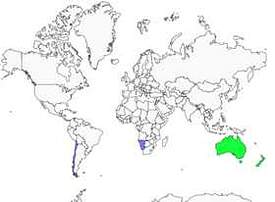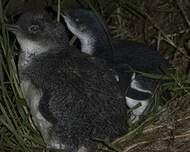Little Penguin
Eudyptula minor - Manchot pygmée
Identification
Subspecific information 6 subspecies
- Eudyptula minor minor (w and s South Island and Stewart Island. New Zealand.)
- Eudyptula minor novaehollandiae (Tasmania, s Australia)
- Eudyptula minor iredalei (n North Island. New Zealand.)
- Eudyptula minor variabilis (s North Island. New Zealand. , Cook Strait)
- Eudyptula minor albosignata (e South Island. New Zealand.)
- Eudyptula minor chathamensis (Chatham Is.. New Zealand.)
Foreign names
- Manchot pygmée,
- Pingüino enano,
- pinguim-anão,
- Zwergpinguin,
- kék pingvin,
- Dwergpinguïn,
- Pinguino minore,
- dvärgpingvin,
- Dvergpingvin,
- tučniak malý,
- tučňák nejmenší,
- Dværgpingvin,
- sinipingviini,
- Kleinpikkewyn,
- pingüí petit,
- pingwin mały,
- Малый пингвин,
- コビトペンギン,
- 小企鹅,
- dvärgpingvin,
- 小企鵝,
Habitat
Marine Neritic : Pelagic, Subtidal Rock and Rocky Reefs, Subtidal Loose Rock/pebble/gravel, Subtidal Sandy, Subtidal Sandy-Mud, Macroalgal/Kelp, Seagrass (Submerged) ; Marine Oceanic : Epipelagic (0-200m), Mesopelagic (200-1000m) ; Marine Intertidal : Rocky Shoreline, Sandy Shoreline and/or Beaches, Sand Bars, Spits, Etc ; Marine Coastal/Supratidal : Sea Cliffs and Rocky Offshore Islands, Coastal Sand Dunes
Threats - protection
IUCN conservation status
Extinct
Threatened
Least
concern
concern
Extinc
in the Wild
in the Wild
Near
threatened
threatened
Not
evaluated
evaluated
EX
EW
CR
EN
VU
NT
LC
NE
Other sources of interest
- Accipitriformes
- Aegotheliformes
- Anseriformes
- Apodiformes
- Apterygiformes
- Bucerotiformes
- Caprimulgiformes
- Cariamiformes
- Casuariiformes
- Charadriiformes
- Ciconiiformes
- Coliiformes
- Columbiformes
- Coraciiformes
- Cuculiformes
- Eurypygiformes
- Falconiformes
- Galliformes
- Gaviiformes
- Gruiformes
- Leptosomiformes
- Mesitornithiformes
- Musophagiformes
- Nyctibiiformes
- Opisthocomiformes
- Otidiformes
- Passeriformes
- Pelecaniformes
- Phaethontiformes
- Phoenicopteriformes
- Piciformes
- Podargiformes
- Podicipediformes
- Procellariiformes
- Psittaciformes
- Pterocliformes
- Rheiformes
- Sphenisciformes
- Steatornithiformes
- Strigiformes
- Struthioniformes
- Suliformes
- Tinamiformes
- Trogoniformes




















